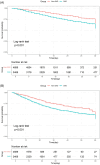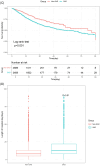A machine learning-based prediction model for sepsis-associated delirium in intensive care unit patients with sepsis-associated acute kidney injury
- PMID: 40456706
- PMCID: PMC12131538
- DOI: 10.1080/0886022X.2025.2514186
A machine learning-based prediction model for sepsis-associated delirium in intensive care unit patients with sepsis-associated acute kidney injury
Abstract
Sepsis-associated acute kidney injury (SA-AKI) patients in the ICU often suffer from sepsis-associated delirium (SAD), which is linked to unfavorable outcomes. This research aimed to develop a machine learning-based model for early SAD prediction in SA-AKI patients. Data was sourced from the Medical Information Mart for Intensive Care IV (MIMIC-IV) and eICU Collaborative Research Database (eICU-CRD). Various models, including logistic regression, extreme gradient boosting (XGBoost), random forest, k-nearest neighbors, support vector machine, decision tree, and naive Bayes, were constructed and evaluated. The XGBoost model emerged as the best, with an internal validation AUROC of 0.775 and an external validation AUROC of 0.687. Unlike traditional delirium assessments, this model enables earlier SAD prediction and is suitable for patients who are hard to assess conventionally.
Keywords: MIMIC-IV database; eICU-CRD database; machine learning; predictive model; sepsis-associated acute kidney injury; sepsis-associated delirium.
Conflict of interest statement
No potential conflict of interest was reported by the author(s).
Figures










References
Publication types
MeSH terms
LinkOut - more resources
Full Text Sources
Medical
